
Bioluminescent occurs when energy is released from chemical reactions occurring inside (or ejected by) the organism.
The animal kingdom is full of fascinating organisms that have the ability to glow. Most people know about the humble firefly, but the vast majority of glowing animals actually lurk deep within the oceans. If you’ve ever ventured beneath the surface in a submarine, you can sometimes catch glimpses of ghostly flickers looming against the dark backdrop of the immense undersea depths.
These marine organisms look a bit like an alien spacecraft or some strange technology. But the main purpose of the glow is far more conventional: it has evolved to attract mates, lure prey, confuse predators, or communicate with other members of the same species.
There are two main ways that animals emit light. The first method is to absorb light from the surrounding environment and then emit it back. This process is known scientifically as biofluorescence. The second method, known as bioluminescence, occurs when the animal produces light on its own. This requires a complex chemical reaction often involving a special class of proteins called luciferase, produced within a separate light-producing organ. The chemical reaction creates cold light of blue, green, or yellow (rarely red) that gives off little heat. If it did produce heat, then it would probably kill the organism. Most animals, humans included, emit a small amount of light, but it’s normally so subtle that only a specialized camera can capture it. The 10 animals on this list, however, are some of the most conspicuous light-producing animals in the entire world.
#10 Fireflies

Fireflies have specialized light-emitting organs that are typically located in their abdomens.
©Fer Gregory/Shutterstock.com
The firefly (also known as the lightning bug) is a family of beetles, encompassing around 2,000 known land species. During the summer, they light up the night sky with their amazing bioluminescent ability. The main purpose of the glow is to attract mates. It’s been demonstrated (in a few species at least) that females will choose mates based on the intensity and rate of their flash patterns. The glow also serves as a kind of warning to predators. Because of its rather unpalatable taste, predators might think twice before trying to eat one again. The firefly can control the chemical reaction by adding oxygen to the light-emitting organ in its body. The oxygen reacts with other compounds (including luciferase) to produce light. They first evolved this ability back when the dinosaurs still roamed the planet. Unfortunately, they do face several modern threats, including pesticide use and the confusion caused by artificial lights.
#9 Bioluminescent Fungus Gnats
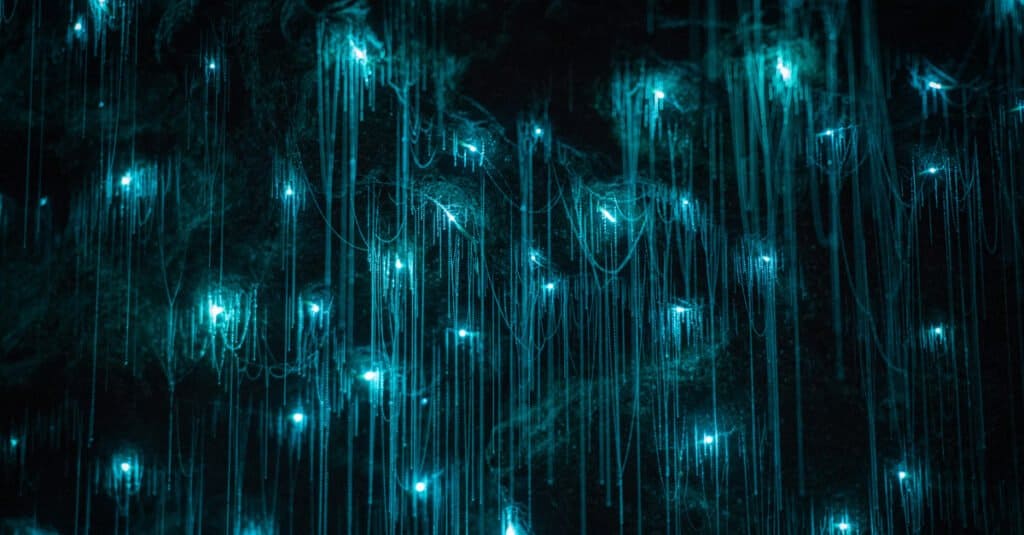
These insects that are native to Australia and New Zealand are a sight to behold as they light up caves and hang from rocks.
©Shaun Jeffers/Shutterstock.com
These insects are called glow worms in their larval stages, but the name is a bit of a misnomer. These are not really worms at all, but rather gnats. They are actually a member of the fly order. They also possess a unique bioluminescent ability found nowhere else in the animal kingdom. Native to Australia and New Zealand, the larvae are attached to the ceiling of a cave or the bottom of a rock. They create spindly mucus-filled threads that hang down from the ceiling and give off an ethereal kind of beauty, but its true purpose is to attract prey such as spiders and midges. Once the prey is trapped within the mucus, the larvae will consume them whole. This is only a temporary arrangement, however. After reaching adulthood, the gnat loses its glowing ability and looks much more like a typical flying insect.
#8 Angler Fish

Carnivorous, the angler fish has a luminescent organ that dangles to attract prey.
©Neil Bromhall/Shutterstock.com
The angler fish (an entire order of animals, encompassing more than 200 species) looks like the kind of terrifying deep-sea predators that will induce nightmares. But this gruesome-looking fish has a fascinating bioluminescent organ. The long, sinewy lure that extends like a pole from the back of the female is actually a modified dorsal fin. The end of the lure lights up thanks to bioluminescent bacteria living inside of the angler fish. This symbiotic relationship between fish and bacteria probably came about by a chance encounter, but it’s also a handy shortcut; the fish does not have to evolve a bioluminescent system from scratch.
The main purpose of the lure is to attract prey. Animals seem naturally drawn to the bright light, and it’s no coincidence that the lure sits within striking distance of the grizzly teeth. But it has also another important purpose: the light helps the female find a suitable mate in the dark depths of the ocean. Angler fish mating is an interesting phenomenon in its own right. The males look so different from the females that they almost appear like different species. Once they’ve found a proper mate, the male will actually fuse into her body, forming a unique symbiotic relationship.
However, the angler fish isn’t the only marine animal with a lure. The unrelated viperfish has a similar rod-like instrument that attracts prey with its magnificent light. Once they are within range, the viperfish will immobilize and trap prey with its long fang-like teeth. This animal can also produce bluish light around its stomach with specialized organs called photophores. It’s believed that the glow may serve the purpose of hiding the silhouette of the fish from dangerous predators against the dim blue light of the water.
#7 Jellyfish
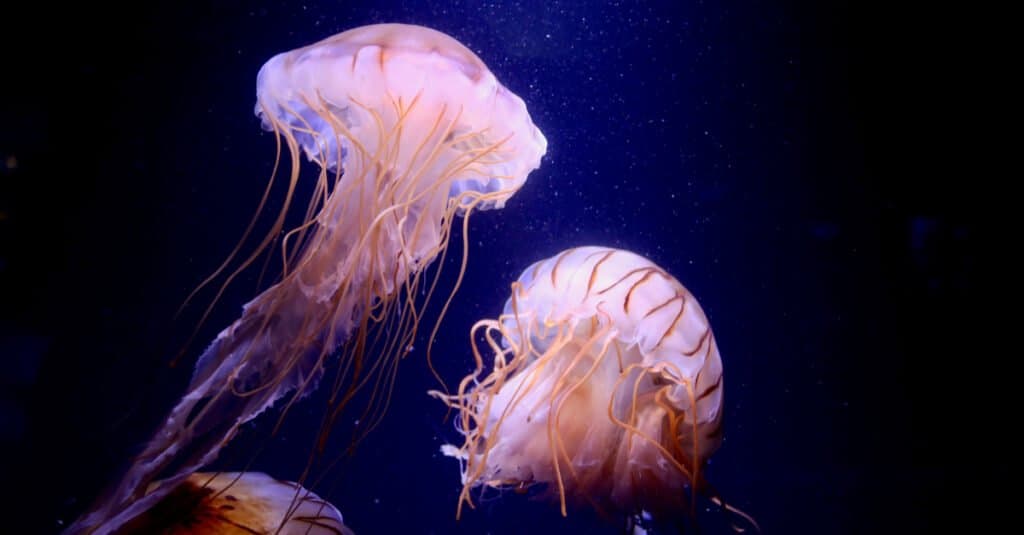
Used for self-defense and luring its prey, the jellyfish lights up waters all over the world.
©Nagisa GOGO 0515/Shutterstock.com
The humble jellyfish is perhaps the most bioluminescent animal on the planet. It’s estimated that about half of the 2,000 or so known species exhibit some kind of glowing ability. The most common use of light in jellyfish is to escape from predators. Some jellyfish produce bright flashes to startle predators, while others release glowing particles or decoys as a distraction.
The brilliant light emitted by jellyfish can also help them find a meal. Glowing in the dark can help a jelly disguise itself as zooplankton while seeking its own prey. These creatures of the sea get a lot of great use from their light-producing power. It helps them eat and avoid being eaten!
#6 Krill
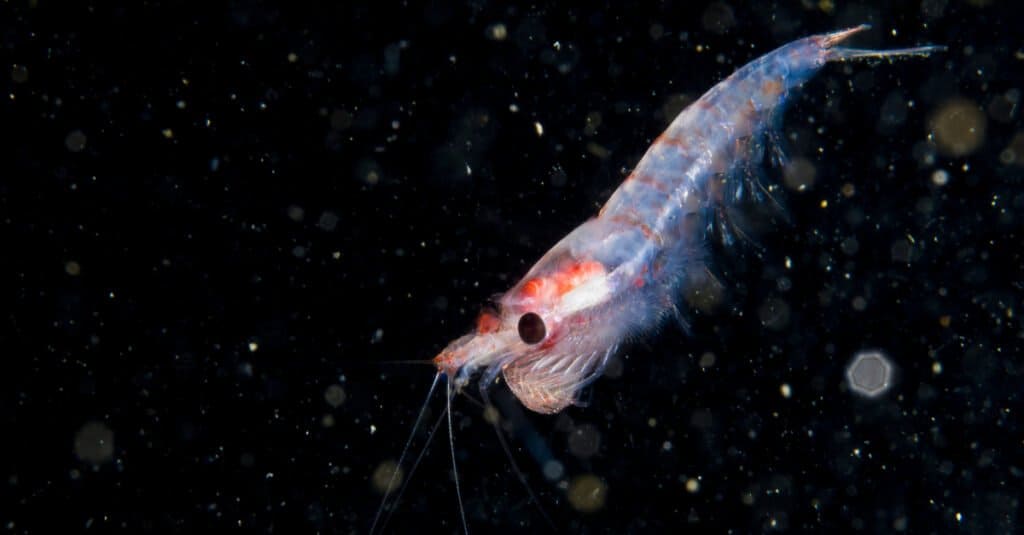
Scientists theorize that krill light up to sound an alarm when predators are near, but they have no definitive conclusion.
©RLS Photo/Shutterstock.com
The krill are tiny marine crustaceans, most of them measuring no more than an inch or two long. They are very common prey for larger marine organisms like whales, which sweep them up in the thousands. These inconspicuous organisms also have the amazing ability to produce light from their bodies. Some species even have a special rotatable lens to direct the light toward a specific area. The reason behind this is unclear. It may have something to do with mating or schooling behavior.
#5 Bioluminescent Sharks

The lantern shark, only found in the deep sea, is one of quite a few species of sharks that emit light.
©NOAA\NMFS\Mississippi Laboratory / CC BY 3.0, from Wikimedia Commons, the free media repository – License
It’s estimated that around 57 species, or just under 10% of all sharks, can produce some kind of light. The most well-known, perhaps, is the aptly named lantern shark. This small animal lurks in the deep dark sea, deploying the glow to camouflage itself against the faint blue light of its environment. In March 2021, scientists also discovered that a large predatory shark called the kitefin is also able to produce light. Measuring some 3 to 5 feet, it is the largest known bioluminescent vertebrate yet discovered. Unlike most bioluminescent sharks, which have glowing undersides to blend in from below, the entire body of the kitefin can produce light. The purpose of this isn’t yet fully understood.
#4 Firefly Squid
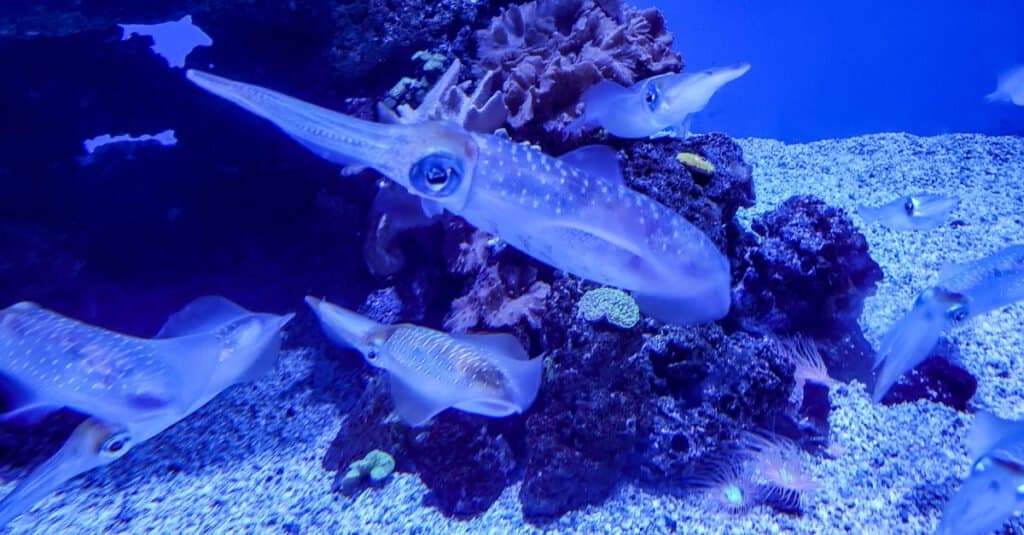
The firefly squid produces a blue light that scientists believe may be used for communication, camouflage, or attracting food.
©Circe Denyer / Creative Commons – License
While only a few species of squids are able to light up, the firefly squid is a spectacular exception. These tiny animals, measuring about 3 inches long, spend their winter living in the deep sea. During the summer, they travel to their spawning grounds off the shores of Japan, where they put on a spectacular light show, probably for the purpose of communication with mates and rivals. These squids emit blue light via a complex organ called the photophores all over their body. This organ is equipped with lenses, shutters, color filters, and reflectors. By controlling these organs, the squid can emit light in any pattern it desires. Unfortunately for them, their bright glow makes them easy to catch by people in great numbers. They are considered to be a culinary delicacy in Japan.
#3 Sea Firefly
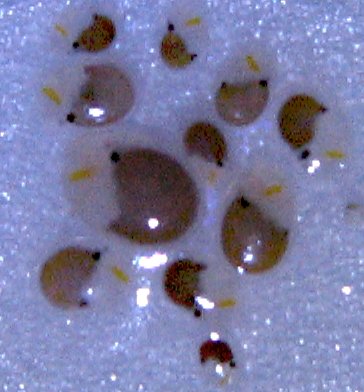
The sea firely is also known as
Vargula hilgendorfii.
©Almandine/CC BY-SA 3.00 – License
The sea firefly is a very small crustacean, measuring less than an inch in length. It lives near the shallow waters of Japan. During the mating season, the male will squirt out bright dots of light to reveal his location to females. It was also used by soldiers in World War II to illuminate messages at night.
Roughly about the size of a sesame seed, these creatures eject clouds of beautiful blue mucus. This mucus is to startle or confuse would-be predators. One of the famous species that produce light is the sea firefly, also known as sea sparkle. However, the ostracod Vargula is known in Japan as the sea firefly.
#2 Tomopteris
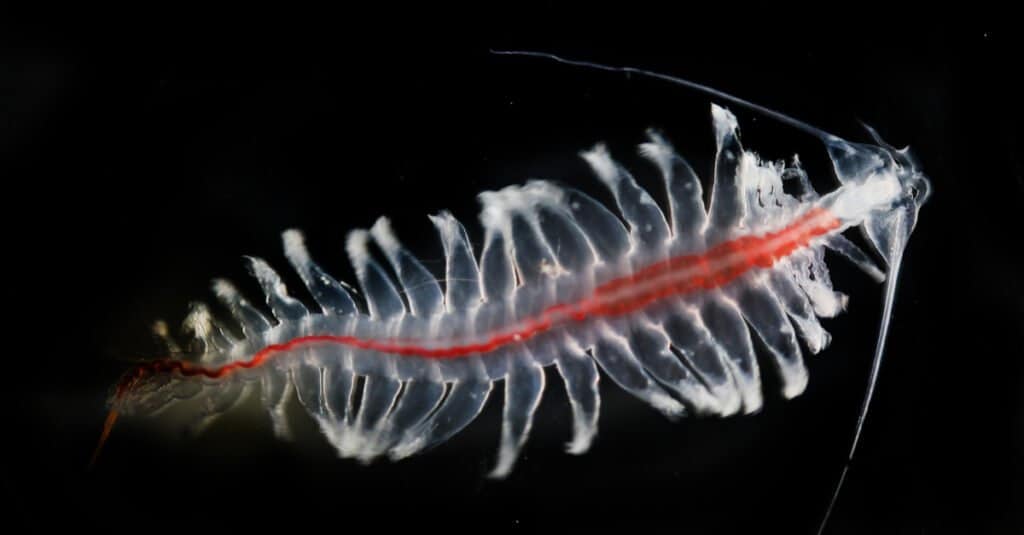
Though it only reaches a few centimeters in length, the tomopteris makes itself known through its bioluminescent glow.
©mitsu1244/Shutterstock.com
Tomopteris is a genus of plankton (small floating marine organisms found all over the world’s oceans). While many types of plankton produce light, this is the only one that produces a rare yellow bioluminescent glow. Based on observation, Tomopteris appears to release the glowing particles from the sinewy protrusions from their body (they look like legs), possibly as a means to distract predators as it makes a safe getaway. The typical Tomopteris measures barely more than an inch in size, so they need all the help they can get to evade predators.
#1 Tasmanian Devil
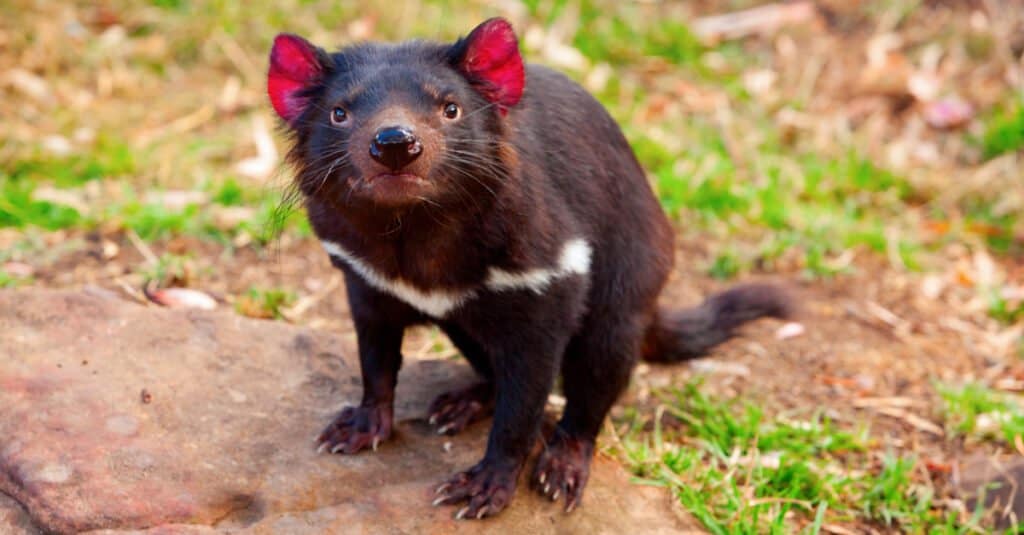
Until recently, no one knew that Tasmanian Devils glow under ultraviolet light.
©Oleksii G/Shutterstock.com
So far, this is one of the few land mammals that could make the list, but its entire discovery was actually an accident. In December 2020, a zoo technician first found that Tasmanian Devils (carnivorous marsupial mammals native to the island of Tasmania) can produce a visible glow under the gaze of ultraviolet light. Special proteins in the skin and fur appear to absorb energy from the sunlight and then emit the energy at dusk in a different wavelength beyond what the human eye can process.
It’s been hypothesized that this glow may play some role in communication. It also opens up the tantalizing possibility that more land mammals could produce or absorb light than we currently know. Both flying squirrels and springhares have been observed to give off a glow under UV light as well.
Summary
Here is our collection of ten animals that use bioluminescence or biofluorescence to light up their environments.
| Rank | Animal That Glows in the Dark |
| 1 | Tasmanian Devil |
| 2 | Tomopteris |
| 3 | Sea Firefly |
| 4 | Firefly Squid |
| 5 | Shark |
| 6 | Krill |
| 7 | Jellyfish |
| 8 | Anglerfish |
| 9 | Fungus Gnat |
| 10 | Firefly |
Honorable Mention:
Are there other animals that glow in the dark? Yes! Here are a few more to add to our list:
- The railroad worm – actually a type of beetle, and the males look like beetles, but the females and juveniles look like larva (thus the worm name) and they can glow! They use the beacon-style light on their head to warn predators that they are toxic. Other tiny lights outline the lower body, so the total picture looks like a train at night (thus the railroad name).
- The Hawaiian bobtail squid lives in the coastal waters of the Hawaiian and Midway Islands in the Pacific. It has a symbiotic relationship with a bioluminescent bacteria called Vibrio fischeri. The squid provides food for the bacteria and, in return, uses the blue-ish bioluminescence to help it blend in with moonlit waters.
- The gray, short-tailed opossum, a native of South America, was recently discovered to fluoresce a hot pink color under black light! It’s not known how this marsupial developed the trait, but that may be one reason that this opossum is now seen in the pet trade in the US and Europe.
The photo featured at the top of this post is © Nagisa GOGO 0515/Shutterstock.com
Thank you for reading! Have some feedback for us? Contact the AZ Animals editorial team.






